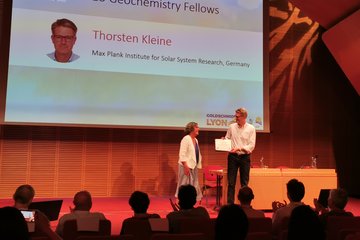Alle Typen
401.
Vortrag
JUICE: Europe's mission to Jupiter. 24th European Cosmic Ray Symposium, Kiel, Germany (2014)
402.
Vortrag
Saturns Monde: Aktive Geysire, Seen aus flüssigem Methan und gefrorene Eiswüsten. Astronomischer Verein Basel, Basel, Switzerland (2014)
403.
Vortrag
Visualizing the Invisible and other wonders of Saturn's magnetosphere. European Planetary Science Congress EPSC, Cascais, Portugal (2014)
404.
Vortrag
Global Flow Patterns in the Jovian Magnetosphere: Galileo/EPD and Galileo/PLS measurements. European Planetary Science Congress EPSC, Cascais, Portugal (2014)
405.
Vortrag
Measurements and modelling of the Jovian and Saturnian radiation belts (solicited). European Geosciences Union General Assembly 2014, Vienna, Austria (2014)
406.
Vortrag
Titan's magnetospheric environment. National Astronomy Meeting, Portsmouth, UK (2014)
407.
Vortrag
Titan's magnetospheric environment. 6th Alfven Conference, London, UK (2014)
408.
Vortrag
Quasi-Periodic injections of relativistic electrons in Saturn's magnetosphere. European Planetary Science Congress EPSC, Cascais, Portugal (2014)
409.
Poster
Studying the seed population of Saturn’s <1 MeV radiation belts using Cassini/MIMI measurements: Energetic Ion moments and polytropic index in Saturn’s magnetosphere. AGU Fall Meeting, San Francisco, CA, USA (2019)
410.
Poster
Weighted CRAND injection coefficients at Saturn. AGU Fall Meeting, San Francisco, CA, USA (2019)
411.
Poster
Magnetospheric Interactions of Saturn's Moon Dione 2005-2015. AGU Fall Meeting, San Francisco, CA, USA (2019)
412.
Poster
Io's interaction with energetic electrons as observed by Juno. AGU Fall Meeting, San Francisco, CA, USA (2019)
413.
Poster
Quantifying Electron Radiation Belt Extensions at Saturn. Conference on the Magnetosphere of the Outer Planets , Sendai, Japan (2019)
414.
Poster
Quasi-periodic latitudinal shift of Saturn's main auroral emission. American Geophysical Union, Fall Meeting 2017, New Orleans, Louisiana (2018)
415.
Poster
Energetic particle periodicities during the Cassini Grand Finale. AGU Fall Meeting, New Orleans, USA (2017)
416.
Poster
Electromagnetic Quasi-periodic Whistler-mode bursts during Ring grazing passes. AGU Fall Meeting, New Orleans, USA (2017)
417.
Poster
The search for active Europa plumes in Galileo plasma particle detector data: the E12 flyby. AGU Fall Meeting, New Orleans, USA (2017)
418.
Poster
The search for Europa plume signatures in Galileo in-situ data. DPG-Frühjahrstagung 2017, Bremen (2017)
419.
Poster
The search for Europa plume signatures in Galileo plasma particle data. Magnetospheres of the Outer planets conference (MOP), Uppsala, Sweden (2017)
420.
Poster
The search for active Europa plumes in Galileo plasma particle detector data: the E12 flyby. AGU Fall Meeting, New Orleans, USA (2017)











